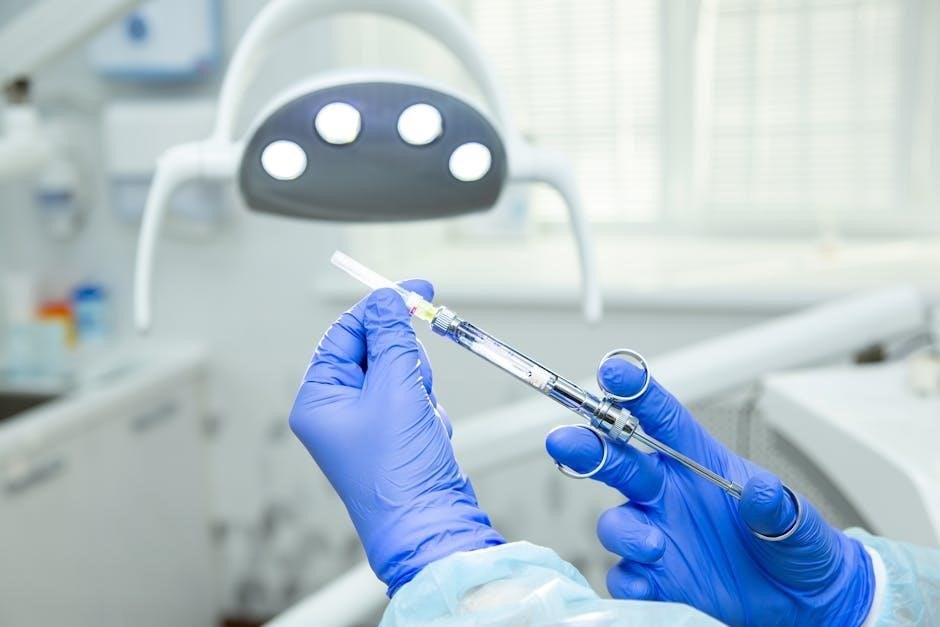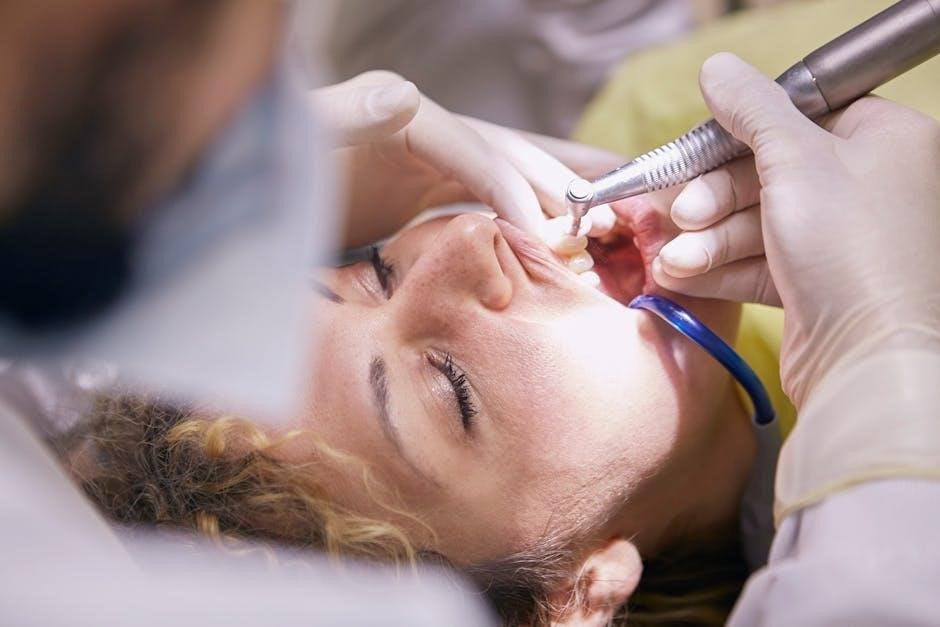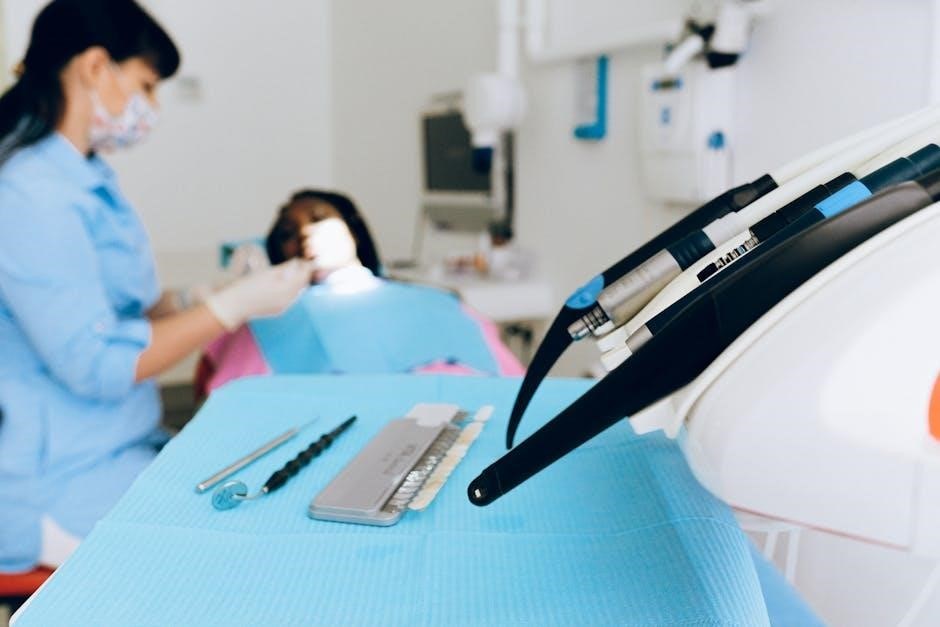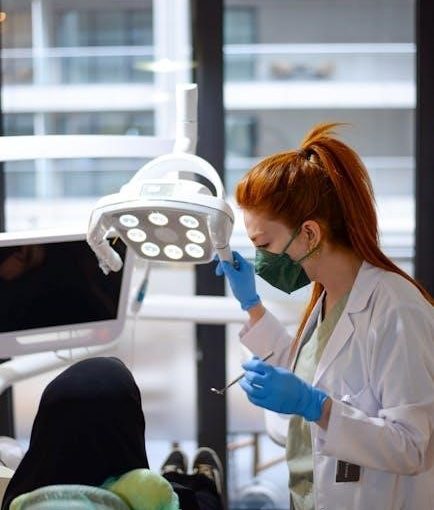This manual, offered as a template, assists in developing a robust policy and procedure manual for your medical practice, ensuring effective daily operations and compliance.
It’s designed for clarity, providing concise procedures, and is crucial for maintaining a well-organized medical office, as highlighted by Bizmanualz’s updated resources.

Purpose of the Manual
This manual’s core purpose is to establish a standardized framework for all medical office operations, ensuring consistent, high-quality patient care and efficient workflows. Serving as a central reference point, it clarifies expectations for all staff members regarding their roles and responsibilities.
The manual aims to minimize errors, promote legal and ethical compliance – particularly with HIPAA – and facilitate smooth audits or inspections. It’s a template designed to be adapted, providing clear policies and procedures for everything from patient registration to financial management. Ultimately, this document supports the medical practice’s goal of delivering optimal healthcare services, as demonstrated by fully accredited clinics like Optimal Health Medical Clinic.
Scope and Applicability
This medical office policy and procedure manual encompasses all aspects of the practice’s daily operations, applying to every employee – clinical and administrative – regardless of position or employment status. It governs interactions with patients, handling of medical records, financial transactions, and adherence to legal regulations.
The manual’s scope extends to all locations associated with the practice, ensuring uniformity across the organization. It’s designed for use in a Provider Based Rural Health Clinic setting, but adaptable for various medical homes, including pediatric practices utilizing template policies. Proper implementation requires consistent review and updates to maintain relevance and effectiveness, as highlighted by the need for a robust revision history.
Revision History and Control
Maintaining an accurate revision history is paramount for the effectiveness of this medical office policy and procedure manual. A detailed log, including version numbers, dates of edits, the name of the person making changes, and specific notes outlining the modifications, will be diligently maintained.
This control system ensures all staff members utilize the most current policies and procedures. The manual will undergo periodic review – at least annually – or as necessitated by changes in regulations (like HIPAA or OSHA) or practice workflows. Access to previous versions will be restricted to authorized personnel, safeguarding the integrity of the document and supporting audit trails.

Patient Management Policies
Patient care begins with streamlined policies covering registration, appointments, check-in/out, and a clear process for addressing patient complaints effectively.

Patient Registration and Intake Procedures
Patient registration is the foundational step in delivering quality care. This procedure outlines a standardized process for collecting essential patient demographics, insurance details, and medical history.
All new patients must complete a registration form, available both in print and potentially online, prior to their first appointment. Staff are responsible for verifying insurance coverage and obtaining necessary authorizations.
Intake includes reviewing the patient’s current medications, allergies, and past medical conditions. Accurate documentation within the medical record is paramount, adhering to established standards. Proper channels for clarification, such as contacting the Medical Record Department, are defined.

This ensures a comprehensive and efficient start to the patient’s journey within the clinic.
Appointment Scheduling and Confirmation
Appointment scheduling aims to optimize provider time and patient access. Staff will utilize the practice management system to schedule appointments, considering patient needs and provider availability.
Specific time slots are allocated for different appointment types, ensuring adequate time for each visit. A confirmation system, including phone calls or automated reminders, is implemented to minimize no-shows.
Patients are responsible for confirming their appointments within a specified timeframe. Failure to confirm may result in cancellation.
The manual details procedures for handling cancellations and rescheduling requests, prioritizing efficient office flow and maximizing patient care.
Patient Check-In and Check-Out Procedures
Patient check-in begins with verifying demographic and insurance information, ensuring accuracy for billing and record-keeping. Patients will complete necessary forms, including consent and privacy acknowledgements, as outlined in the manual.
Staff will collect co-payments or outstanding balances at check-in. Following the appointment, the check-out process involves scheduling follow-up appointments, providing medical records requests forms, and addressing any patient questions.
Detailed billing statements are provided, and patients are informed of payment options.
These procedures, detailed within the medical office policy and procedure manual, aim for a smooth, efficient, and patient-focused experience.
Handling Patient Complaints and Grievances
Patients have the right to voice concerns, and this policy outlines a clear process for addressing complaints and grievances. All staff members are trained to listen empathetically and document concerns thoroughly, as detailed in the medical office policy and procedure manual.
Initial attempts to resolve issues should occur at the front desk or with the treating provider; If unresolved, patients can submit a formal written complaint to the office manager.
A timely investigation will be conducted, and the patient will receive a written response outlining the findings and resolution. Proper channels, including physician contact, are available.
Maintaining open communication and a commitment to patient satisfaction are paramount.

Medical Records Management
Medical record integrity is vital; this section details policies for documentation standards, release of information, chart reviews, and proper record retention/destruction.
Release of Medical Information Policy
This policy outlines the procedures for appropriately responding to requests for medical information, ensuring full HIPAA compliance. Proper channels for requests include direct contact with the attending physician, healthcare provider, or the designated Medical Record Department.
All requests must be submitted in writing, with valid patient authorization; Verification of patient identity is paramount before releasing any information.
The manual details specific forms and documentation requirements for authorization, including the scope of information to be released and the recipient.
Denial of requests, with appropriate justification, will also be documented. Maintaining a clear audit trail of all releases is essential for accountability and legal protection.
Medical Record Documentation Standards
Comprehensive and accurate medical record documentation is vital for quality patient care, legal defensibility, and appropriate billing. This section details standards for all entries, emphasizing clarity, objectivity, and completeness.
All documentation must be legible, dated, and signed by the rendering provider, including credentials.
Entries should reflect the patient’s history, examination findings, diagnoses, treatment plans, and any changes in condition.
Corrections must be made with a single line through the error, initialed and dated – never obliterated.
Adherence to these standards, as outlined in the manual, ensures a reliable and legally sound patient record.
Chart Review Protocols
Regular chart reviews are essential for ensuring documentation accuracy, completeness, and compliance with coding and billing regulations. This procedure outlines the process for systematic medical record evaluation.
Reviews will be conducted by designated personnel, focusing on key elements like problem lists, medication reconciliation, and treatment plan alignment with diagnoses.
A sample chart review protocol, as referenced in the manual, will be utilized to standardize the process and identify areas for improvement.
Findings will be documented and reported to the appropriate parties for corrective action, promoting continuous quality improvement within the practice.
Proper channels for inquiries include the attending physician or the Medical Record Department.
Retention and Destruction of Medical Records
This policy establishes guidelines for the secure retention and lawful destruction of medical records, adhering to both federal and state regulations. Records will be maintained for a minimum period, typically seven years from the date of last encounter, but may vary based on specific record type.
Destruction will be conducted via secure methods, such as shredding or degaussing, ensuring patient confidentiality.
A detailed schedule outlining retention periods for different record categories is maintained by the Medical Record Department.
All destruction activities will be documented, including the date, method, and personnel involved, as outlined in the manual’s procedures.
Compliance with these guidelines is paramount to avoid legal ramifications.

Office Administration Policies
This section details office hours, staff roles, telephone etiquette, emergency protocols, and supply management – crucial for smooth daily medical office function.
Office Hours and Staff Responsibilities
Standard office hours are Monday through Friday, 8:00 AM to 5:00 PM, with a one-hour lunch break staggered to ensure continuous patient coverage. Reception staff are responsible for patient check-in/out, appointment scheduling, and insurance verification.
Medical assistants support physicians with patient care, documentation, and preparing examination rooms. Clinical staff maintain patient charts and adhere to strict documentation standards. All personnel must uphold professional conduct and dress code guidelines.
Specific duties are outlined in individual job descriptions, and ongoing training is provided to enhance skills and ensure compliance with medical office policies and procedures, as detailed within this manual.
Telephone Etiquette and Communication
All staff answering telephones must adhere to a professional standard, utilizing a friendly and courteous tone. Answer within three rings, identifying the clinic with a standardized greeting. Proper channels for urgent medical inquiries include directly contacting the attending physician or the Medical Record Department.
Confidential patient information must never be discussed in public areas; Detailed communication protocols are outlined in this manual, emphasizing clear and concise messaging. Voicemail greetings should be professional and include instructions for leaving detailed messages.
Effective communication is vital for patient care and office efficiency, ensuring a positive experience for all.
Handling Emergency Situations
This medical office maintains a detailed emergency response plan, outlined within this manual, to address various scenarios – from medical emergencies to fire or natural disasters. All staff members are required to be familiar with evacuation routes and emergency contact information.
In the event of a medical emergency, prioritize patient safety and immediately notify the appropriate healthcare provider. Proper channels for assistance include calling 911 and alerting the attending physician.
Detailed incident reporting procedures are also included, ensuring thorough documentation of all emergency events. Regular drills will be conducted to maintain preparedness.
Office Supply Management
Efficient office supply management is crucial for smooth daily operations. This manual details procedures for ordering, receiving, and stocking essential supplies, including both clinical and administrative items. A template office supplies list is maintained and regularly updated by the designated staff member.
All supply requests must be submitted through the approved requisition process. Inventory levels will be monitored to prevent shortages and minimize waste. Cost-effective purchasing practices are prioritized, and adherence to budgetary guidelines is expected.
Optimal Health Medical Clinic exemplifies a well-stocked facility, and we strive for similar efficiency in our practice.

Financial Policies
This manual outlines billing and coding, insurance verification, patient payment expectations, and collection procedures, ensuring financial health for the medical practice.
Billing and Coding Procedures
Accurate billing and coding are paramount for financial stability and legal compliance within the medical practice. This section details the standardized coding systems – CPT, ICD-10, and HCPCS – utilized for service documentation and claim submission.
Procedures cover claim scrubbing protocols to minimize errors, ensuring clean claims are submitted to payers. Staff training on coding updates and compliance is mandatory, as outlined in the manual.
The manual also specifies the process for appealing denied claims, documenting all communication, and adhering to payer-specific guidelines. Consistent application of these procedures maximizes reimbursement and minimizes audit risks, supporting the practice’s financial health.
Insurance Verification and Claims Submission
Prior to service, comprehensive insurance verification is essential to determine patient benefits and coverage details. This procedure involves confirming eligibility, copayments, deductibles, and any pre-authorization requirements, as detailed in the manual.
Claims submission follows strict timelines and formats dictated by each payer. The manual outlines the electronic claims submission process, including the use of clearinghouses and adherence to HIPAA standards.
Documentation of all verification attempts and claim submission details is crucial for tracking and follow-up; Regular audits of claim submission accuracy are conducted to ensure optimal reimbursement and minimize denials, supporting the practice’s revenue cycle.
Patient Payment Policies
Clear patient payment policies are vital for financial stability. This manual section details accepted payment methods – cash, checks, credit cards – and outlines procedures for collecting copayments, deductibles, and patient responsibility amounts at the time of service.
Payment arrangements, if offered, are documented with a signed agreement outlining the terms. The policy addresses potential financial hardship cases, ensuring compassionate and consistent handling.
Statements are generated and mailed promptly, with clear explanations of charges. The manual emphasizes respectful communication regarding outstanding balances and adherence to established collection procedures, maintaining positive patient relationships.
Collection Procedures
Effective collection procedures, detailed in this manual, begin with initial billing statements and follow a progressive approach. Patient accounts are monitored regularly, and overdue balances trigger a series of actions – reminder calls, then letters – documented meticulously.
The policy outlines timelines for each step, ensuring consistency and compliance. Third-party collection agencies are utilized only as a last resort, following strict vetting and contractual agreements.
All collection efforts adhere to relevant regulations, maintaining patient confidentiality and respecting their rights. Detailed records of all communication and actions are maintained, supporting transparency and accountability within the medical office.

Compliance and Legal Considerations
This section details HIPAA and OSHA protocols, alongside incident reporting procedures, ensuring the medical office operates legally and protects patient information.
HIPAA Compliance Procedures
Maintaining strict HIPAA compliance is paramount within the medical office. This necessitates comprehensive policies governing Protected Health Information (PHI) access, use, and disclosure. Procedures must outline employee training on privacy rules, including proper handling of medical records and patient data.
Specifically, the manual should detail protocols for obtaining patient authorization for information release, safeguarding against breaches, and responding to potential violations. Proper channels for addressing concerns, like contacting the Medical Record Department, must be clearly defined. Regular audits and updates to these procedures are essential to adapt to evolving regulations and ensure ongoing adherence to HIPAA standards.
OSHA Safety Protocols
Establishing and maintaining robust OSHA safety protocols is critical for a secure medical office environment. This manual section details procedures for hazard communication, including proper handling of biohazardous materials and sharps disposal. Employees must receive thorough training on infection control measures, personal protective equipment (PPE) usage, and emergency response procedures.
Protocols should address workplace safety, encompassing everything from ergonomic assessments to fire safety plans. Regular safety inspections and documentation of incident reporting, as outlined in compliance guidelines, are essential. Adherence to these OSHA standards minimizes risks, protects both staff and patients, and demonstrates a commitment to a safe healthcare setting.
Incident Reporting Procedures
Comprehensive incident reporting procedures are vital for maintaining patient safety and legal compliance within the medical office. This section of the manual outlines the steps for documenting any unusual occurrence, including patient falls, medication errors, or breaches in security. Employees are required to report all incidents, regardless of severity, through designated channels – often involving the attending physician or Medical Record Department.
Detailed reports should include date, time, location, individuals involved, and a clear description of the event. Proper documentation facilitates investigation, corrective action, and risk management, ensuring continuous improvement in patient care and a safer work environment.

Human Resources Policies
This section details employee conduct, dress code, training, and performance evaluations, establishing clear expectations for all staff within the medical practice.
Employee Conduct and Dress Code
Professionalism is paramount; all employees are expected to maintain respectful interactions with patients, colleagues, and visitors. A positive and courteous demeanor contributes to a welcoming medical office environment.
The dress code requires a neat, clean, and professional appearance. Acceptable attire includes business casual clothing – scrubs may be required for clinical staff. Visible tattoos and piercings should be discreet.
Employee behavior must align with ethical standards and legal requirements, including strict adherence to HIPAA regulations. Any form of harassment or discrimination will not be tolerated. This policy, as part of the broader manual, ensures a productive and respectful workplace.
Employee Training and Development
Optimal Health Medical Clinic prioritizes continuous employee growth. All new hires will undergo comprehensive onboarding, covering office protocols, medical record systems, and HIPAA compliance.
Ongoing training will include updates on coding changes, new medical advancements, and safety protocols – aligning with OSHA standards. Opportunities for professional development, such as workshops and certifications, are encouraged.
This policy, detailed within the manual, ensures staff competency and adherence to best practices. Regular performance evaluations will identify individual training needs, fostering a skilled and knowledgeable team dedicated to patient care and office efficiency.
Performance Evaluation Procedures
Performance evaluations are conducted annually, utilizing a standardized form outlined in this manual. The process involves self-assessment, supervisor review, and a collaborative discussion focused on strengths and areas for improvement.
Evaluations assess job performance against established criteria, including clinical skills, patient interaction, adherence to policies, and teamwork. Documentation of performance, both positive and constructive, is maintained in the employee’s personnel file.
This procedure supports employee development and identifies training needs, aligning with the clinic’s commitment to a highly skilled workforce. Consistent evaluations ensure accountability and contribute to a positive and productive office environment.
